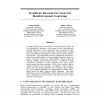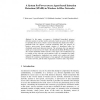1028 search results - page 112 / 206 » Simulation in the future |
NIPS
1998
14 years 11 months ago
1998
A simple learning rule is derived, the VAPS algorithm, which can be instantiated to generate a wide range of new reinforcementlearning algorithms. These algorithms solve a number ...
IDT
2010
14 years 8 months ago
2010
Humans know how to reason based on cause and effect, but cause and effect is not enough to draw conclusions due to the problem of imperfect information and uncertainty. To resol...
SUTC
2008
IEEE
15 years 4 months ago
2008
IEEE
A piece of Hovering Information is a geo-localized information residing in a highly dynamic environment such as a mobile ad hoc network. This information is attached to a geograph...
BROADNETS
2004
IEEE
15 years 1 months ago
2004
IEEE
Channel-aware scheduling and link adaptation (LA) methods are widely considered to be crucial for realizing high data rates in wireless networks. Multi-carrier systems that spread...
ICCNMC
2005
Springer
15 years 3 months ago
2005
Springer
In this paper, we propose a distributed hierarchical intrusion detection system, for ad hoc wireless networks, based on a power level metric for potential ad hoc hosts, which is us...


